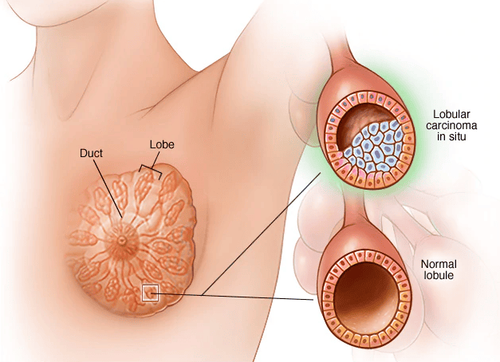This is an automatically translated article.
The article was professionally consulted by Specialist Doctor II Do Tuong Huan - Oncologist - Oncology Center - Vinmec Central Park International General Hospital.Cancer is the collective name for a collection of related diseases. In any cancer, there are abnormal cells, which are normal cells of the body, but now divide, multiply out of control, invade surrounding tissues and can cause cancer. can metastasize.
1. What is cancer?
Cancer can appear in nearly any of the trillions of cells in the body. Normally, cells grow and divide to form new cells, which is how the human body grows and develops. Inevitably, old cells will gradually age or be damaged, die, and be replaced by new cells.When cancer appears, the natural process is disrupted. The cells become more and more abnormal, the old old cells do not die but continue to grow, continuously producing new cells. They keep multiplying uncontrollably, and eventually form the abnormal mass we call a tumour.
Many types of cancer form solid tumors, most of which are solid masses of tissue in nature. Blood cancers, such as leukemia, do not usually present as solid tumors.
Tumors in cancer are malignant, which means they have the ability to invade the surrounding area. During the process of growth, cancer cells can travel to other areas of the body through the circulatory or lymphatic systems, forming new tumors that are completely separate from the original tumor. is metastasis.
Unlike malignant tumors, benign tumors are not invasive, although sometimes benign tumors are also very large in size. When surgically removed tumors, benign tumors usually do not recur (while melanoma very often recur). However, benign tumors are not always harmless, as in the case of benign brain tumors, which can be life-threatening.
2. The difference between normal cells and cancer cells
Cancer cells are different from normal cells in many ways, which allows them to have the ability to multiply indefinitely and invade the surrounding area. One very important difference between cancer cells and normal cells, is that cancer cells are less differentiated. While normal cells are born, grow, mature, and differentiate into different types of cells that perform different functions, cancer cells are poorly or undifferentiated. And that's the reason why cancer cells can divide and multiply to no avail - something normal cells don't have.In addition, cancer cells are not affected by the body's "command" to stop dividing, and they also escape a process called "apoptosis" - which is the body's way of digging Eliminate unnecessary cells.
Cancer cells can influence the microenvironment around it, including normal cells, molecules and the blood vessels that nourish the tumor. That is, cancer cells have the ability to stimulate normal cells to form blood vessels to supply oxygen, nutrients and waste waste to nourish and grow tumors.
Cancer cells also have the ability to bypass the body's immune system. Normally, the human body's immune system is responsible for fighting inflammation, as well as eliminating abnormal or damaged cells. However, cancer cells have the ability to "hide" before the body's immune system, thereby not being destroyed.
Not only bypassing the immune system, tumors can also use the immune system to survive and grow. For example, tumors can take advantage of certain immune cells to send false signals, so that the immune system will not proceed to eliminate cancer cells.

Hình ảnh so sánh tế bào thường và tế bào ung thư
3. When cancer invades and metastasizes
Cancer has the ability to invade the surrounding area, and in particular, form a new tumor in a location completely separate from the original tumor site, called metastatic cancer. The process by which cancer cells move to another location to form a new tumor is called metastasis.The name of the metastatic cancer as well as the type of metastatic cancer cell is exactly the same as the original cancer. For example, breast cancer that causes metastatic tumors in the lungs would be called metastatic breast cancer, not lung cancer.
Pathologically, metastatic cancer cells are often the same as those in the original tumor. Furthermore, at the molecular level, metastatic cancer cells and cancer cells in the primary tumor are similar, such as having the same chromosomal variation.
Treatment can prolong the life of patients with metastatic cancer. Usually the goal of treatment is to control the growth of the cancer as well as relieve the symptoms it causes. Metastatic tumors can cause serious complications, and most cancer patients die as a result of metastasis.
4. Tissue changes that aren't cancerous
Not every change in tissue means cancer is present, although there are changes that, if left untreated, have the potential to progress to cancer. Here are some examples of tissue changes that are not cancerous, but need to be monitored in some cases:Hyperplasia: occurs when cells in a tissue divide faster than normal often, leading to a rapid increase in the number of cells. However, in terms of histopathology, tissue and cell organization were still normal. Hyperplasia is caused by a variety of causes and conditions, including chronic stimuli. Dysplasia: is a more serious condition than hyperplasia. In dysplasia, not only does the number of cells increase rapidly, but histologically, the tissues and cells also become abnormal. And the greater the degree of abnormality, the higher the risk of developing cancer. Some types of dysplasia need to be monitored and treated, for example: an abnormal mole on the skin (melanoma dysplasia) can progress to melanoma (although this will not happen in most cases). ). A more serious case is carcinoma in situ. Although it is sometimes called cancer, it is not cancerous in nature, because the abnormal cells do not invade beyond the basal membrane of the starting tissue, which means that it does not invade the surrounding area like normal cells. cancer cells. However, carcinoma in situ can easily progress to cancer and should be treated.
5. Types of cancer
There are now more than 100 different types of cancer. The naming of cancers is usually based on the tissue or organ where the cancer started, for example, lung cancer that starts in the lung cells. In addition, the name of cancer is also based on the type of cell it forms, such as epithelial or squamous cells.Here are some cancers that start with certain types of cells:
5.1 Carcinoma Carcinoma is the most common type of cancer. It originates from epithelial cells, which are the cells that cover the inner and outer surfaces of the body. There are many different types of epithelial cells, and thus each type of carcinoma has its own name:
Adenocarcinoma is a cancer that forms from epithelial cells that secrete mucus and secretions. Tissues containing these epithelial cells are often referred to as glandular tissues. Most breast, colon, and prostate cancers are adenocarcinomas. Basal cell carcinoma is a type of cancer that originates in the basal cell layer of the epidermis - the outermost layer of human skin. Squamous cell carcinoma is a cancer that originates from squamous cells, a type of epithelial cell of the skin, but squamous cells are also present in many other organs, such as the gastrointestinal tract, lungs, bladder, kidney, ... Under the microscope, squamous cells are flattened, like fish scales. Squamous cell carcinoma is also sometimes called epidermal carcinoma. Transitional cell carcinoma is a type of cancer that forms from epithelial tissue called transitional tissue. This type of tissue is made up of many different layers of epithelial cells, large and small, and occurs in organs such as the bladder, ureters, renal pelvis, and a few others. Some cancers of the bladder, ureters, and kidneys are transitional cell carcinomas.

Đa số ung thư vú là adenocarcinoma
Osteosarcoma is the most common type of bone cancer. The most common soft tissue sarcomas are leiomyosarcoma, Kaposi sarcoma, malignant fibrous histiocytoma, liposarcoma, and dermatofibrosarcoma protuberans.
5.3 Leukemia Leukemia is cancer that begins in the hematopoietic tissues of the bone marrow. These cancers do not form solid tumors. Instead, a huge number of abnormal white blood cells are present in the blood and bone marrow, crowding out normal blood cells, leading to many consequences such as oxygen deprivation to tissues, blood clotting. disorder, body susceptible to infection,...
There are four common types of leukemia, grouped based on acute or chronic nature, and the type of blood cell in which the cancer begins.
5.4 Lymphoma Lymphoma is a type of cancer that originates in the lymphocytes (T cells and B cells). These white blood cells are part of the immune system and play a role in fighting infections. With lymphoma, abnormal lymphocytes appear increasingly in the lymph nodes and lymphatic system as well as in other organs of the body.
Lymphoma has two main types:
Hodgkin's Lymphoma: in this lymphoma there is an abnormal type of lymphocyte called Reed - Sternberg (usually of B cell origin).
Non-Hodgkin Lymphoma: includes a large collection of cancers that start in lymphocytes, either B cells or T cells. Progression of the disease is fast or slow depending on the disease.
5.5 Multiple myeloma Multiple myeloma is a cancer that starts in plasma cells - a type of immune cell. Abnormal plasma cells arise from the bone marrow and form tumors in the bone. Multiple myeloma is also known as Kahler's disease.
5.6 Melanoma Melanoma originates in melanocytes, which are specialized cells that produce melanin - the substance that gives skin color. Most melanomas appear on the skin, but can also appear in other tissues such as the eyes.
5.7 Brain and spinal cord tumors There are many different types of brain and spinal cord tumors. The tumor's name is based on the type of cell that makes up the tumor and the primary location of the tumor in the central nervous system, such as astrocytomas originating from astrocytes. Brain tumors can be benign or malignant (cancerous).

Hình ảnh u não
Germ cell tumors are tumors that originate from cells that later develop into eggs or sperm. These tumors can appear anywhere in the body and can be either benign or malignant.
Neuroendocrine tumors
Neuroendocrine tumors form from cells that secrete hormones into the bloodstream in response to nerve signals. These tumors (which can be benign or malignant) secrete more hormones than usual, causing a variety of symptoms.
Carcinoid tumor
Carcinoid tumor is a type of neuroendocrine tumor. They are slow growing and are usually found in the gastrointestinal tract (especially the rectum and small intestine). Carcinoid tumors can spread to the liver and other places in the body, and secrete substances such as serotonin or prostaglandins, causing carcinoid syndrome.
Specialist Doctor II Do Tuong Huan has 20 years of experience in the examination, diagnosis and surgical treatment and chemotherapy of cancer pathologies. Dr. Huan used to work for a long time at Ho Chi Minh City Oncology Hospital from 1999 to 2017 and now works at Vinmec Central Park International General Hospital from March 2017.
Please dial HOTLINE for more information or register for an appointment HERE. Download MyVinmec app to make appointments faster and to manage your bookings easily.
References: Cancer.gov












